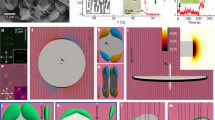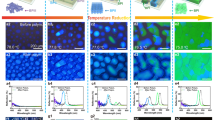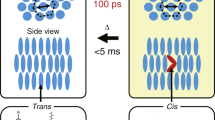Abstract
Materials whose structure or electrical or optical properties can be controlled with light are said to be photoactive. Liquid crystals are of interest as photoactive media, because their fluidity maintains the possibility of molecular motion in response to photon absorption, while their orientational and/or positional ordering offers the possibility of cooperative behaviour that can amplify relatively weak photochemical effects. Moreover, liquid crystals impose their own ordering on solutes. For example, smectic A liquid crystals, comprised of one-dimensional stacks of fluid layers with the molecular axes aligned normal to the layers1, produce a modulation in solute concentration with a period equal to the layer spacing2,3. Here we present computer simulations which show that the positional ordering of a photoactive solute (an azobenzene derivative, denoted 7AB) in a smectic host (denoted 8CB) depends sensitively on its photochemical state. The photoactive molecules are driven from within the smectic layers to locations between the layers by trans-to-cis photoisomerization. This would explain the recent observation4,5,6,7 of a reversible increase in the smectic A layer spacing of a solution of 7AB in 8CB accompanying the photoisomerization process. The effect might be exploited for low-power, high-resolution optical data storage, and more generally for the manipulation of organic materials at the nanometre scale.
This is a preview of subscription content, access via your institution
Access options
Subscribe to this journal
Receive 51 print issues and online access
$199.00 per year
only $3.90 per issue
Buy this article
- Purchase on Springer Link
- Instant access to full article PDF
Prices may be subject to local taxes which are calculated during checkout




Similar content being viewed by others
References
De Gennes, P. G. & Prost, J. The Physics of Liquid Crystals (Clarendon, Oxford, (1993)).
Rieker, T. P. Organic lyotropic lamellar liquid crystals. Liq. Cryst. 19, 497–500 (1995).
Guymon, C. A.et al. Effects of monomer structure on their organization and polymerization in a smectic liquid crystal. Science 275, 57–59 (1997).
Folks, W. R.et al. Low-power laser induced instabilities in smectic A liquid crystals. Mol. Cryst. Liq. Cryst. 261, 259–270 (1995).
Folks, W. R., Reznikov, Yu. A., Yarmolenko, S. N. & Lavrentovich, O. D. Light-induced periodic lattice of defects in smectic A and C liquid crystals: structural and dynamical aspects. Mol. Cryst. Liq. Cryst. 292, 183–197 (1997).
Krentsel, T. A., Lavrentovich, O. D. & Kumar, S. In-situ x-ray measurements of light-controlled layer spacing in a smectic liquid crystal. Mol. Cryst. Liq. Cryst. 304, 463–469 (1997).
Folks, W. R.et al. Photocontrol of smectic spacing. Mol. Cryst. Liq. Cryst. 320, 77–88 (1998).
Berendsen, H. J. C., Postma, J. P. M., van Gunsteren, W. F., Dinola, A. & Haak, J. R. Molecular dynamics with coupling to an external bath. J. Chem. Phys. 81, 3684–3690 (1984).
Glaser, M. A., Clark, N. A., Garcia, E. & Walba, D. M. Quantum chemistry based force fields for soft matter. Spectrochim. Acta A 53, 1325–1340 (1997).
Essman, U.et al. Asmooth particle mesh Ewald method. J. Chem. Phys. 103, 8577–8593 (1995).
Allen, M. P. & Tildesley, D. J. Computer Simulation of Liquids (Oxford Univ. Press, (1987)).
Tuckerman, M., Berne, B. J. & Martyna, G. J. Reversible multiple time scale molecular dynamics. J. Chem. Phys. 97, 1990–2001 (1992).
Sexton, J. C. & Weingarten, D. H. Hamiltonian evolution for the hybrid Monte Carlo algorithm. Nucl. Phys. B 380, 665–677 (1992).
Ikeda, T., Sasaki, T. & Ichimura, K. Photochemical switching of polarization in ferroelectric liquid-crystal films. Nature 361, 428–430 (1993).
Sasaki, T., Ikeda, T. & Ichimura, K. Photochemical control of properties of ferroelectric liquid crystals: photochemcial flip of polarization. J. Am. Chem. Soc. 116, 625–628 (1994).
Sasaki, T. & Ikeda, T. Photochemical control of properties of ferroelectric liquid crystals. 1. Effect of structure of host ferroelectric liquid crystals on the photochemical switching of polarization. J. Phys. Chem. 99, 13002–13007 (1995).
Sasaki, T. & Ikeda, T. Photochemical control of properties of ferroelectric liquid crystals. 2. Effect of the structure of guest photoresponsive molecules on the photochemical switching of polarization. J. Phys. Chem. 99, 13008–13012 (1995).
Sasaki, T. & Ikeda, T. Photochemical control of properties of ferroelectric liquid crystals. 3. Photochemically induced reversible change in spontaneous polarization and electrooptic property. J. Phys. Chem. 99, 13013–13018 (1995).
Coles, H. J., Walton, H. G., Guillon, D. & Poetti, G. Photomechanically induced phase transitions in ferroelectric liquid crystals. Liq. Cryst. 15, 551–558 (1993).
Glaser, M. A.et al. Computer-aided design of ferroelectric liquid crystals. Mol. Phys. Rep. 10, 26–47 (1995).
Yamaguchi, H. & Nakanishi, H. Characterization of the preparation process and the photochemical control of electrical properties of bilayer lipid membranes containing azobenzene chromophores. Biochim. Biophys. Acta 1148, 179–184 (1993).
Acknowledgements
We thank T. Darden for use of his particle-mesh Ewald code, D. Coleman for help in producing the molecular graphics, and D. Finotello and B. Zalar for discussions. This work was supported by the NSF, the US Air Force Office of Sponsored Research, and the Kent State Liquid Crystal Institute (a grant of computer time).
Author information
Authors and Affiliations
Corresponding author
Rights and permissions
About this article
Cite this article
Lansac, Y., Glaser, M., Clark, N. et al. Photocontrolled nanophase segregation in a liquid-crystal solvent. Nature 398, 54–57 (1999). https://doi.org/10.1038/17995
Received:
Accepted:
Issue Date:
DOI: https://doi.org/10.1038/17995
This article is cited by
-
Thermophysical Parameters Evaluation by Pyroelectric Detection
International Journal of Thermophysics (2018)
-
Structure and dynamics of mesogens using intermolecular potentials derived from ab initio calculations
Theoretical Chemistry Accounts (2007)
-
Preparation and photochemical behavior of a cationic azobenzene dye-montmorillonite intercalation compound
Journal of Wuhan University of Technology-Mater. Sci. Ed. (2007)
Comments
By submitting a comment you agree to abide by our Terms and Community Guidelines. If you find something abusive or that does not comply with our terms or guidelines please flag it as inappropriate.



